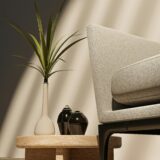Sound is one of the most present yet often least understood dimensions of space. While light, colours, and materials capture our attention as we enter, acoustics work quietly yet powerfully – as an invisible layer that defines how we experience a space. Good acoustics bring a sense of calm, clarity, and focus.
In homes, we encounter noise every day – from footsteps above us to the hum of appliances or echoes in our own kitchen. In workplaces, the acoustic environment directly affects concentration, efficiency, and overall well-being. The World Health Organization warns that noise is not only disturbing but can also have long-term effects on the cardiovascular and nervous systems.
Contemporary architecture, with its open floor plans, concrete walls, and glass surfaces, only intensifies acoustic challenges. These materials give spaces a minimalist aesthetic but reflect sound and create echo. Acoustics are both a technical parameter and a sensory experience. The concept of the “soundscape” in modern architecture means that we no longer deal only with reducing noise but also with creating a balanced acoustic atmosphere.
In restaurants, this means clear but not overpowering conversation; in offices, the possibility of focus without complete silence; and in homes, a soft acoustic background. A good architect today treats sound as a material: planning how it travels, where it reflects, and where it is absorbed. Silence is not the absence of sound but the presence of balance.
Acoustic challenges and principles of good design
At the core of acoustic design are three key principles: isolation, absorption, and reflection.
Sound isolation prevents noise transmission between rooms – typically between neighbouring apartments or offices. The key is to combine dense materials (concrete, brick) with elastic intermediate layers (rubber, wool) that dampen vibrations. Even the smallest gaps around sockets, pipes, or doors can drastically reduce insulation performance, which is why precision in detailing is crucial.
Sound absorption deals with the internal soundscape of a space – how much sound is reflected from walls, ceilings, and floors. Textiles, carpets, acoustic panels made of recycled PET felt, slatted wall cladding, and upholstered furniture elements reduce echo and create a pleasant acoustic balance.
Reflection keeps a space alive. Absolute silence feels sterile, so the goal is controlled reflection that gives a room warmth and depth. Acoustics must always adapt to context. In residential settings, the biggest problems are footsteps, music, service shafts, and vibrations. The solution lies in a combination of construction measures (floating screeds, acoustic linings, sealed joints) and soft furnishings that reduce resonance.
In work environments, the challenge is the opposite – too much openness. Open-plan offices without acoustic protection cause fatigue and lower concentration. Effective solutions include acoustic partitions, textile screens, ceiling absorbers, and furniture with sound-dampening functions, such as phone booths or upholstered meeting niches.
Measurements, materials, and standards
The quality of acoustics cannot be assessed “by ear” but through precise measurements. Using microphones and sound generators, acousticians determine reverberation time (RT60) and sound insulation (Rw). Measurement results form the basis for an accurate acoustic remediation project and prevent random, ineffective solutions.
Slovenian and European regulations (SIST 113, EN ISO 16283) set minimum sound protection values. In residential buildings, walls between rooms must achieve at least 52–55 dB, and floor structures 53 dB. In offices and public spaces, reverberation time should generally remain below 0.8 seconds. These standards are not a bureaucratic burden but a tool for ensuring healthy, comfortable spaces.
Modern acoustic solutions are not only technically effective but also sustainable and aesthetically refined. New-generation materials include panels made from recycled PET, hemp and flax fibres, perforated wood, or biodegradable composites. Slatted walls and ceilings combine sound absorption with decorative function, shaping the space both visually and acoustically.
Silence as value and investment
Today, a property’s value is determined not only by location, size, and materials but also by its invisible qualities – light, air, energy efficiency, and sound. Good acoustics increase market appeal by creating spaces where people simply feel better. A buyer may not ask for measurements, but they immediately perceive the difference between a quiet and a noisy home.
For investors, acoustics are a long-term economically sound decision: they improve living quality, reduce complaints from residents, and increase property value. In business environments, they lead to better working conditions, less stress, and higher efficiency. Silence is thus becoming the new currency of urban life – and one of the key indicators of high-quality architecture.
For more information or consultation, contact us: Tel: 00386-40-626-131; Email: tajnistvo@bazarealestate.com.





